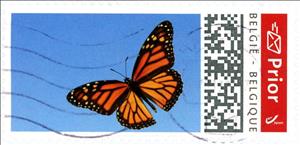Stamp: Butterfly (Personalized and Private Mail Stamps 2020)
Butterfly (Personalized and Private Mail Stamps 2020)
27 January (Personalized and Private Mail Stamps ) within release Belgium : MyStamps goes into circulation Stamp Butterfly face value Prior No Face Value
| Stamp Butterfly in catalogues | |
|---|---|
| Colnect codes: | Col: BE-PER 2020-01/2 |
Stamp is square format.
Face value €1.18, but sold by BPost in panes of ten for €12.80Also in the issue Belgium : MyStamps:
- Mini Sheet - Priority Mail Rate Stamps face value 10*1;
- Stamp - Butterfly face value Prior;
- Stamp - Balloos face value Prior;
- Stamp - Birds face value Prior;
- Stamp - Flamingo face value Prior;
- Stamp - Flowers face value Prior;
- Stamp - Frog face value Prior;
- Stamp - Toucan face value Prior;
- Stamp - Umbrellas face value Prior;
Stamp Butterfly it reflects the thematic directions:
Animals are multicellular, eukaryotic organisms of the kingdom Animalia (also called Metazoa). All animals are motile, meaning they can move spontaneously and independently, at some point in their lives. Their body plan eventually becomes fixed as they develop, although some undergo a process of metamorphosis later on in their lives. All animals are heterotrophs: they must ingest other organisms or their products for sustenance.
Butterflies are insects in the macrolepidopteran clade Rhopalocera from the order Lepidoptera, which also includes moths. Adult butterflies have large, often brightly coloured wings, and conspicuous, fluttering flight. The group comprises the large superfamily Papilionoidea, which contains at least one former group, the skippers (formerly the superfamily "Hesperioidea") and the most recent analyses suggest it also contains the moth-butterflies (formerly the superfamily "Hedyloidea"). Butterfly fossils date to the Paleocene, which was about 56 million years ago. Butterflies have the typical four-stage insect life cycle. Winged adults lay eggs on the food plant on which their larvae, known as caterpillars, will feed. The caterpillars grow, sometimes very rapidly, and when fully developed, pupate in a chrysalis. When metamorphosis is complete, the pupal skin splits, the adult insect climbs out, and after its wings have expanded and dried, it flies off. Some butterflies, especially in the tropics, have several generations in a year, while others have a single generation, and a few in cold locations may take several years to pass through their whole life cycle. Butterflies are often polymorphic, and many species make use of camouflage, mimicry and aposematism to evade their predators. Some, like the monarch and the painted lady, migrate over long distances. Many butterflies are attacked by parasites or parasitoids, including wasps, protozoans, flies, and other invertebrates, or are preyed upon by other organisms. Some species are pests because in their larval stages they can damage domestic crops or trees; other species are agents of pollination of some plants. Larvae of a few butterflies (e.g., harvesters) eat harmful insects, and a few are predators of ants, while others live as mutualists in association with ants. Culturally, butterflies are a popular motif in the visual and literary arts.


